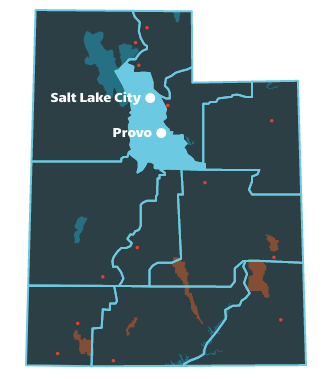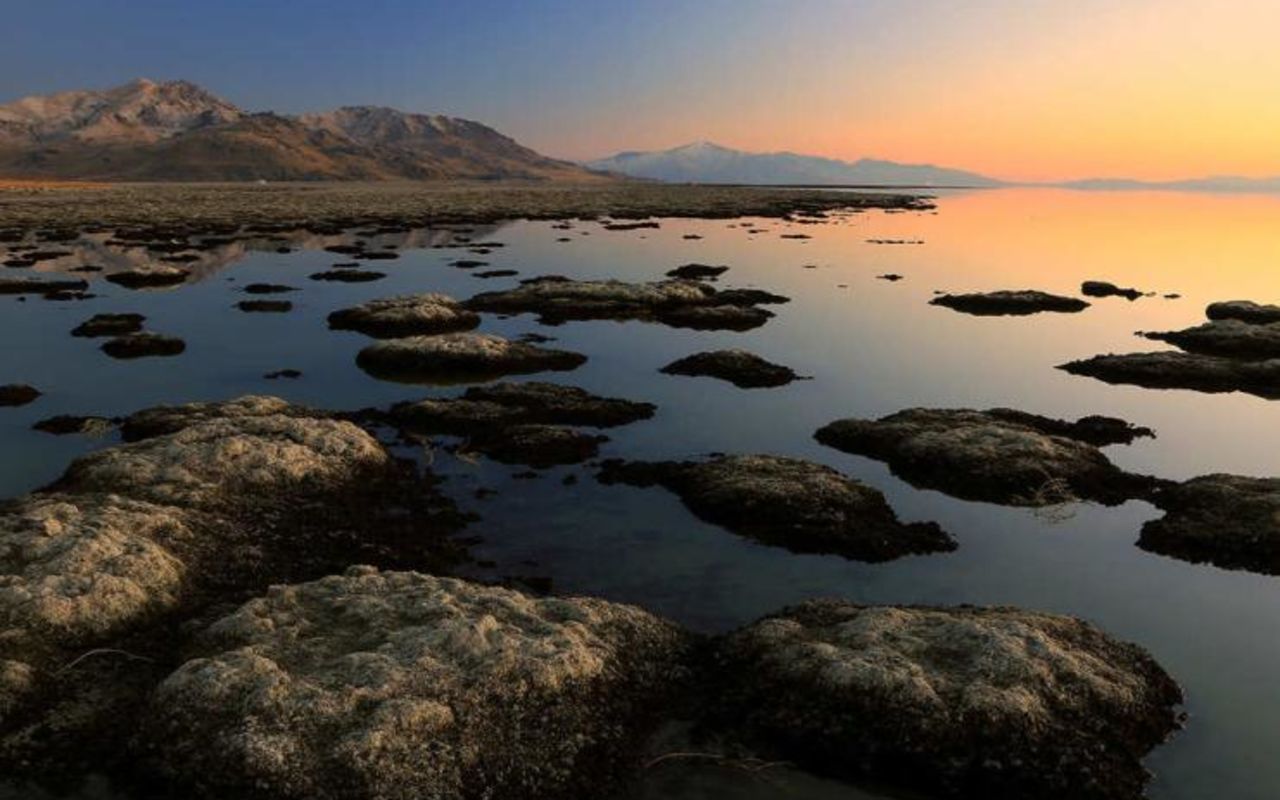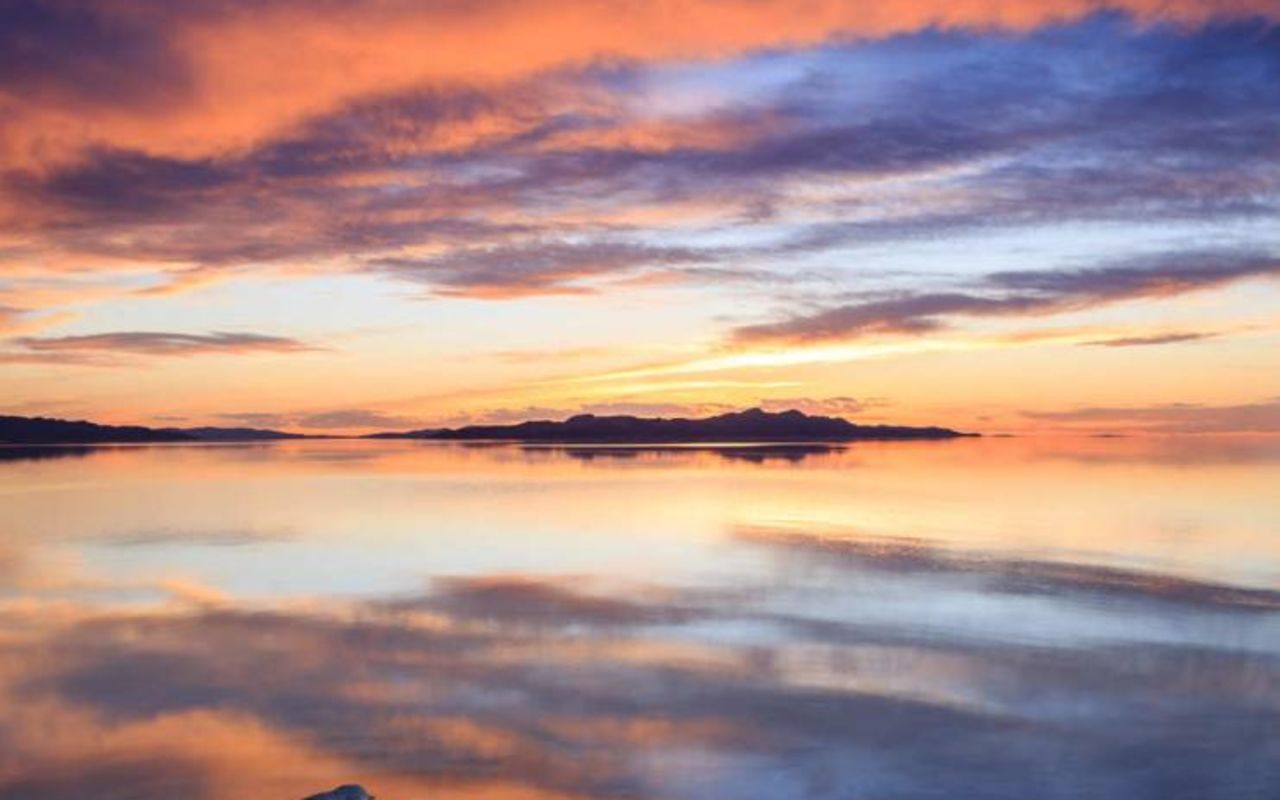The Great Salt Lake
The largest salt water lake in the Western Hemisphere.
The Great Salt Lake and its islands provide outstanding scenery and recreational opportunities in northern Utah. Sunsets over the lake can be breathtaking. Amazing red, orange, lavender and magenta hues slowly dissolve in the evening sky. The lake's turquoise waters attract sailors, its white sand beaches are popular with swimmers and sunbathers, and craggy outcroppings on Antelope Island and some shoreline areas draw hikers and mountain bikers. Read more...
The Great Salt Lake is one of the most asked-about tourist destinations in Utah. A remnant of the massive ancient Lake Bonneville, the lake is now landlocked and its waters are salty. It is the largest lake between the Great Lakes and the Pacific Ocean, and is the largest saltwater lake in the Western Hemisphere.
Legends abound about the lake. Early explorers thought the lake was an inland extension of the Pacific Ocean, or that a river connected the lake to the ocean. Some Indians and early settlers thought the lake was inhabited by a terrible monster with an enormous head. The lake and its legends are an intriguing part of Utah's landscape and history.
Recreation
Excellent views of the lake are available from:
- Ensign Peak on the north edge of Salt Lake City
- Bench areas in the cities of Bountiful, Centerville and Farmington
- Trails on Antelope Island
- Interstate 80 along the lake's south shoreline
Swimming and sunbathing are popular on the clean, white sand beaches at Antelope Island State Park. The salinity of the water averages about 12%, making it much saltier than the ocean. The water is so buoyant that people can easily float. Freshwater showers are available to rinse off after swimming.
Sailing is popular on the lake and full-service marinas are available at Antelope Island and Great Salt Lake State Marina on the south shore. On overcast days, the horizon on the lake blends into the sky and the landscape takes on a surreal look: skimming sailboats and the lake's distant islands appear to float midair. However, the lake is shallow (average depth about 20 feet) and even moderate winds can cause rough water. Experience is needed to navigate the lake. Powerboats can also operate on the lake. Motors not rated for saltwater need to be flushed carefully after use. Many people also kayak on the lake.
Wildlife is abundant on Antelope Island and in the lake's shoreline marshes. Bison, antelope, deer, bobcats, coyotes, and elk roam freely on the island and are often seen by visitors. Bird watching is popular at many spots around the lake, including the federally managed Bear River Bird Refuge and the state's Farmington Bay Waterfowl Management Area. The lake's marshes attract large numbers of migratory birds. Duck and goose hunting is allowed in some areas and is usually very good.
Kayaking on the Great Salt Lake is a great way to see some of the areas that you normally wouldn't see. With 10,000 miles of shoreline, it can be one of the most rewarding places to paddle in North America.
Mountain biking is popular on excellent trails on Antelope and Stansbury islands. These areas also offer excellent hiking. Antelope Island also offers excellent facilities for picnicking and camping.
Fish live in the freshwater marshes and inlets, but no fish species can survive in the lake's salty water. Unique brine shrimp thrive in the lake; they are harvested and processed into fish food. Brine flies live on the lake's shorelines and can be annoying. They don't bite but often swarm around humans. Antelope Island beaches are relatively free of brine flies. Winds coming off the lake can carry a "lake stench" at some times of the year. Again, the odor is usually not a problem at Antelope Island.
History
The Great Salt Lake is actually the remainder of prehistoric Lake Bonneville, which covered some 20,000 square miles of land in what is now Utah, Nevada and Idaho some 10,000 to 30,000 years ago. The lake is about 75 miles long and 35 miles wide, with a maximum depth of 33 feet. After a series of wet years, the lake's surface area may be much larger but it will be only a little bit deeper.
Water levels in the lake are far from constant. During its recorded low in 1963, some of the lake's 10 major islands became peninsulas. In 1983, when the lake reached its historic high, it flooded houses, farmland and the nearby freeway. Huge pumps were constructed to deposit excess water into Utah's west desert. The pumps were shut down in 1989.
Four rivers and numerous streams empty into the Great Salt Lake, carrying dissolved minerals. The lake has no outlet so these minerals are trapped. Continual evaporation concentrates the minerals. Several businesses extract table salt and other chemicals from the lake water.
Park Information
There are two Utah State Parks on the Great Salt Lake: Antelope Island State Park and Great Salt Lake State Park. Antelope Island offers clean beaches, a visitor center, marina, historic ranch house, bison and camping. The Great Salt Lake Park offers a marina with boat launching facilities.
Entrance Fees
Day-use fee: $10 per vehicle / $5 Utah senior citizen vehicle / $30 commercial vehicles (8+ people)
RV Camping fee: $40 Partial Hookups / $65 Full Hookups. Full Hookups include water, electrical hookups and limited internet access. A shared dump station is available for use.
Beach camping fee: $20 per night, tents only. These sites can only be accessed on foot. A fire pit and showers are available.
Bike Fee: $2
Reserve campsites through ReserveAmerica.
Getting There
The Great Salt Lake is northwest of Salt Lake City. To reach Antelope Island, drive north on I-15 to Syracuse, then west on State Route 127, following the signs. A causeway allows automobile access to the island. Great Salt Lake State Park is located at the south end of the lake, about 16 miles west of Salt Lake City, along I-80.
THINGS TO DO
ADJACENT DESTINATIONS
REQUEST INFO & BROCHURE
TRAVEL BUREAU INFORMATION
GREAT SALT LAKE STATE PARK MARINA / CAMPGROUND / VISITOR'S CENTER
13312 West 1075 South
Magna, UT 84044
(801) 828-0787 Visitor's Center
1-800-322-3770 RV Camping Reservations
ANTELOPE ISLAND STATE PARK
4528 West 1700 South
Syracuse, UT 84075
(801) 773-2941 Entrance Gate
(801) 725-9263 Visitor's Center
Location
Get DirectionsThings to Do
Salt Lake City Weather
Average Temperature
Average Precipitation
Average Snowfall
Articles
View AllHappy Trails in Piute County
What do Delano Peak, the Paiute ATV trail and Butch Cassidy all have in common? Utah’s Piute County,...
8 Secrets to Sustainable Travel in Park City
Want a big adventure to Park City without a big environmental footprint? Utah.com can help you explo...
Utah County Is Festive As Heck
Fireworks, parades and corn on the cob — oh my! Utah.com has the scoop on the best festivals and fai...
Natural Bridges National Monument: A Hidden Gem, Not a Second Fiddle
An under the radar destination that should be on your radar. Learn all about Natural Bridges, Utah a...
Plan a Guys Getaway in Vernal
Planning a guys trip? Why not hit the ATV trails in Vernal, Utah with your crew? With all kinds of w...
Treat Yourself to a (San Rafael) Swell Winter
The San Rafael Swell is one of Utah’s hidden gems, and it gets even more hidden in the winter. Utah....
Plan a Triathlon of Fun in Greater Zion
Looking for things to do in St. George this fall? In addition to the IRONMAN 70.3 World Championship...
Color Me (Insert Emotion Here): Where to See Cedar City’s Feel-Good Fall Foliage
Richly hued views await you in southern Utah this autumn. Peep the changing leaves on a scenic drive...
Play Outside and See a Play Outside in Cedar City
Take a visit to Cedar City, Utah, and see why its access to both world class theater and stunning ou...
Mapping Out Utah’s Tastiest Cuisine
Getting to know the Beehive State means experiencing its sites and unique flavors. Discover both whe...
Get Your Peach Thrills in Box Elder County
Utah’s Box Elder county is a peachy paradise — part mountain range, part desert, part orchard and al...
9 Highest Peaks Across Utah
Take a peek at the tallest peaks in Utah. From Kings Peak to the Deep Creeks, Utah.com gets to the t...
Paving the Way for Everyone: All-Access Trails in Utah
From a wheelchair accessible waterfall trail to a lakeside boardwalk laden with wildflowers, these U...
Local Legends in Utah
Ever been curious about urban legends in Utah? Utah.com fills you in all things folklore with our gu...


